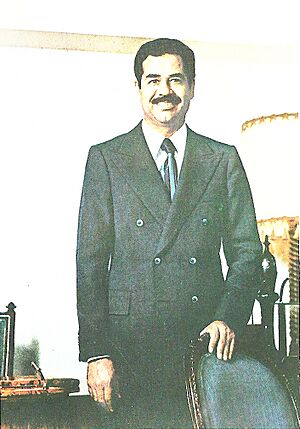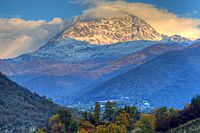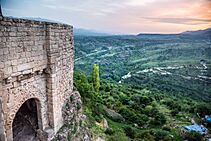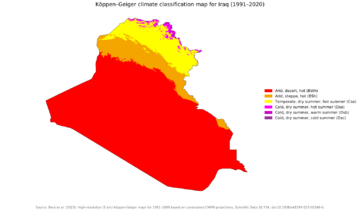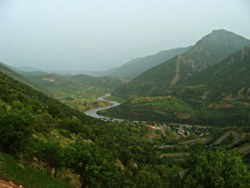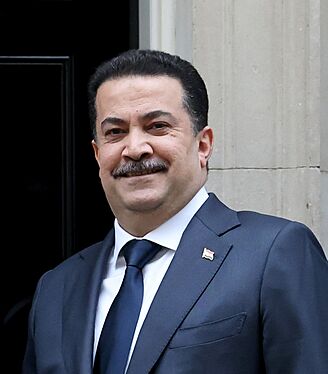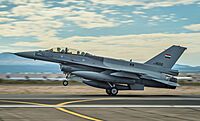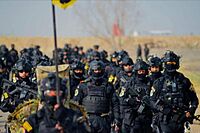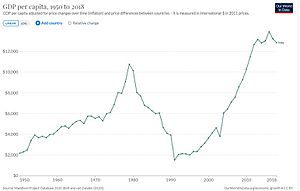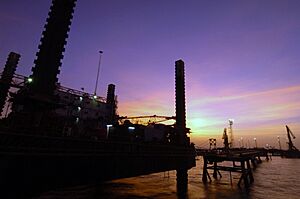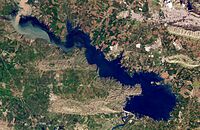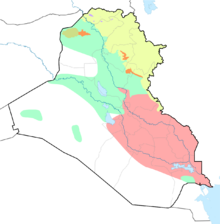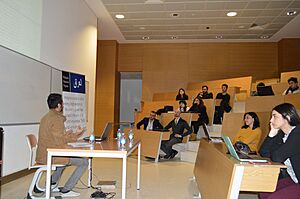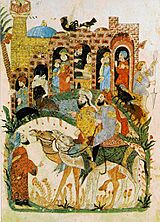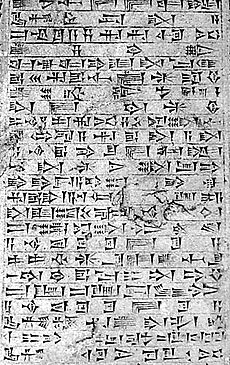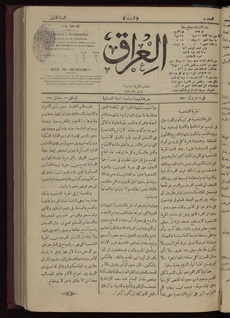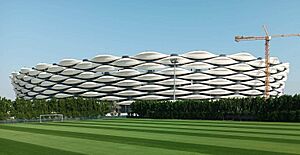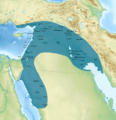Iraq facts for kids
Quick facts for kids
Republic of Iraq
|
|
|---|---|
|
Anthem: مَوْطِنِيْ
Mawṭinī "My Homeland" |
|
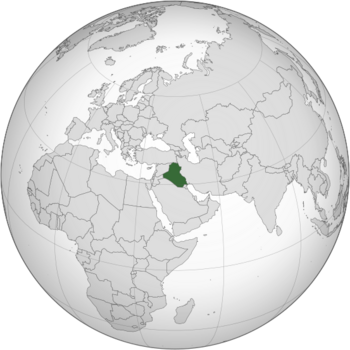 |
|
| Capital and largest city
|
Baghdad 33°20′N 44°23′E / 33.333°N 44.383°E |
| Official languages | |
|
|
| Ethnic groups
(1987)
|
|
| Religion
(2020)
|
|
| Demonym(s) | Iraqi |
| Government | Federal parliamentary republic |
| Abdul Latif Rashid | |
| Muhammad Shayya al-Sudani | |
|
• Speaker
|
Mahmoud al-Mashhadani |
| Legislature | Council of Representatives |
| Federation Council | |
| Council of Representatives | |
| Establishment | |
|
• Independence declared
|
3 October 1932 |
|
• Republic declared
|
14 July 1958 |
|
• Current constitution
|
15 October 2005 |
| Area | |
|
• Total
|
438,317 km2 (169,235 sq mi) (58th) |
|
• Water (%)
|
4.93 (as of 2024) |
| Population | |
|
• 2024 census
|
|
|
• Density
|
82.7/km2 (214.2/sq mi) (125th) |
| GDP (PPP) | 2025 estimate |
|
• Total
|
|
|
• Per capita
|
|
| GDP (nominal) | 2025 estimate |
|
• Total
|
|
|
• Per capita
|
|
| Gini (2012) | 29.5 low |
| HDI (2023) | medium · 126th |
| Currency | Iraqi dinar (IQD) |
| Time zone | UTC+3 (AST) |
| Driving side | right |
| Calling code | +964 |
| ISO 3166 code | IQ |
| Internet TLD |
|
Iraq, officially known as the Republic of Iraq, is a country located in West Asia. It shares borders with Saudi Arabia to the south, Turkey to the north, Iran to the east, and Kuwait to the southeast. The Persian Gulf also touches its southeastern edge. To the southwest lies Jordan, and to the west, Syria.
Iraq covers an area of about 438,317 square kilometers (169,234 sq mi). It is home to over 46 million people, making it the 58th largest country by area and the 31st most populated in the world. Baghdad, with more than 8 million residents, is both the capital and the largest city.
The land between Iraq's Tigris and Euphrates rivers, called Mesopotamia, is famous as the "cradle of civilization." Starting around 6000 BC, this fertile area saw the rise of early cities and empires like Sumer, Akkad, and Assyria. Many important inventions came from here, including writing, mathematics, navigation, timekeeping, the wheel, and early law codes.
After the Muslim conquest of Mesopotamia, Baghdad became the capital of the Abbasid Caliphate. It was a major center for culture and learning during the Islamic Golden Age. However, the city faced decline after being attacked by the Mongols in 1258. Iraq also holds special meaning for followers of Christianity, Judaism, Yazidism, and Mandaeism.
Since gaining independence in 1932, Iraq has seen times of strong economic and military growth. It has also experienced periods of conflict. Iraq was part of the Ottoman Empire until World War I. Then, the British established Mandatory Iraq in 1921. Iraq became an independent kingdom in 1932. After a change in government in 1958, it became a republic.
Today, Iraq is a federal parliamentary republic. It is considered an important country in the Middle East. Iraq has a diverse population, varied geography, and rich wildlife. Most Iraqis are Muslim, but there are also significant groups of Christians, Mandaeans, and Yazidis. The main ethnic groups are Arabs and Kurds, along with Turkmen, Assyrians, and others. Arabic and Kurdish are the official languages. Iraq has one of the world's largest oil reserves, making its oil and gas industry very important. The country is currently rebuilding with international help.
Contents
Understanding the Name of Iraq
The name "Iraq" has a few possible origins. One idea is that it comes from the ancient Sumerian city of Uruk. Another suggestion is that it comes from the Middle Persian word erāg, which means "lowlands." Some people also believe it comes from an Arabic word meaning "deeply rooted" or "fertile."
In the past, there were two regions called ʿIrāq ʿArabī (Arabian Iraq) for southern Mesopotamia and ʿIrāq ʿAjamī (Persian Iraq) for parts of Iran. The term "Iraq" used to refer mainly to the plain south of the Hamrin Mountains. It did not include the northern or western parts of modern Iraq.
When the British helped establish Faisal I of Iraq as king in 1921, the country's official English name changed from "Mesopotamia" to "Iraq." Since 1992, and confirmed in the 2005 Constitution, the official name is the "Republic of Iraq."
A Look at Iraq's Past
Iraq's history is very long and interesting. It largely matches the ancient region of Mesopotamia, often called the "cradle of civilization." This history goes back to the Stone Age, with many important developments leading up to the establishment of the Caliphate in the 7th century AD. After that, the region became known as Iraq.
Ancient Civilizations and Empires

Within Iraq's borders lies the ancient land of Sumer. This civilization appeared between 6000 and 5000 BC. Sumer is known as the world's first civilization, where cities, writing, and large buildings first developed. Iraq was also the heartland of powerful empires like the Akkadian, Babylonian, Neo-Assyrian, and Neo-Babylonian empires. These empires ruled Mesopotamia and much of the Ancient Near East during the Bronze and Iron Ages.
Ancient Iraq was a place of great new ideas. People here developed early written languages, literary works, and made big steps in astronomy, mathematics, and law. This period of local rule ended in 539 BC when the Neo-Babylonian Empire was conquered by the Achaemenid Empire under Cyrus the Great. The city of Babylon became an important capital for the Achaemenid Empire. Ancient Iraq was also home to the world's first Jewish community outside of Israel, which began during the Babylonian exile.
After the Persian Empire took control, the region later came under the rule of the Greeks, Parthians, and Romans. By the 3rd century AD, the Sasanian Empire from Persia took over. During this time, Arab tribes moved into southern Mesopotamia, forming the Lakhmid kingdom.
Iraq in the Middle Ages
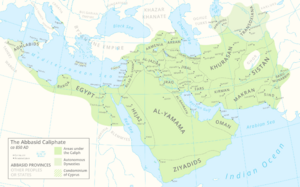
The Arabic name al-ʿIrāq likely came about during this time. The Sasanian Empire was conquered by the Rashidun Caliphate in the 7th century. This brought Iraq under Islamic rule after the Battle of al-Qadisiyyah in 636. The city of Kufa became a key center for the Rashidun dynasty. Later, with the rise of the Abbasid Caliphate in the mid-8th century, Iraq became the center of Islamic rule. Baghdad, founded in 762, served as its capital.
Baghdad thrived during the Islamic Golden Age, becoming a global center for culture, science, and learning. However, its success declined after invasions in the 10th century and suffered greatly during the Mongol invasion in 1258. Iraq then came under the control of the Ottoman Empire in the 16th century. For a period, a local Mamluk dynasty ruled Iraq with some independence from the Ottomans, but the Ottomans regained full control in 1831.
Modern Iraq's Journey
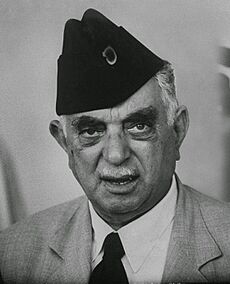
Modern Iraq began after World War I, when the Ottoman Empire collapsed. Arab forces had helped fight the Ottomans, hoping for an independent Arab state. However, European powers had other plans. In 1921, British officials decided that Faisal I of Iraq, who was exiled in London, would become the king of Iraq. This helped maintain British influence while meeting local demands for leadership.
King Faisal worked to unite the land, which was previously divided into three Ottoman areas: Mosul, Baghdad, and Basra. He tried to gain support from all groups, including Sunnis and Shiites. He also focused on education, founding Ahl al-Bayt University in Baghdad. In 1930, Iraq signed a treaty with Britain, giving it some political independence but keeping British control over military presence and oil. Iraq gained full independence in 1932 and joined the League of Nations.
Faisal died in 1933, and his son Ghazi became king. Ghazi's rule was short and challenging. He died in 1939, and his young son, Faisal II, became king at age 3. His uncle, Crown Prince Abdullah, ruled as regent. In 1941, a pro-German government took power, leading to a brief war with Britain. The British won, and the regency continued.
Iraq faced internal divisions, with different ethnic and religious groups feeling left out. In 1958, a military coup, known as the 14 July Revolution, overthrew the monarchy. King Faisal II and the royal family were killed.
Republic and Ba'athist Rule
The 1958 coup brought Brigadier General Abd al-Karim Qasim to power. He ruled Iraq with military control and started to redistribute land. In 1961, he claimed Kuwait as part of Iraq, but the United Kingdom sent its army, forcing him to back down. Qasim was overthrown in 1963 by the Ba'ath Party. After some internal changes, the Ba'ath Party took full power in 1968, with Ahmed Hassan al-Bakr as president.
The government gradually came under the control of Saddam Hussein, who was then vice-president. Saddam tried to bring stability between Iraq's different groups. In the 1970s, the government offered free healthcare and education, took control of the oil industry, and supported women's rights.
In 1980, Saddam declared war on Iran, starting the Iran–Iraq War. This war lasted eight years and caused many deaths. The United States and other Arab countries supported Iraq. In 1990, Iraq invaded Kuwait, leading to the Gulf War. A US-led alliance intervened, defeating Iraq's forces. After the war, sanctions were placed on Iraq, hurting its economy. There were also uprisings by Kurds and Shiite Muslims, which were put down.
Post-Invasion Iraq and Recent Times
In 2003, a US-led coalition invaded Iraq, overthrowing Saddam Hussein's government. This led to a period of conflict and instability. Saddam was captured and executed. From 2006 to 2008, there was a civil war between Shia and Sunni groups. US troops withdrew in 2011.
From 2013 to 2017, Iraq faced another major conflict with the rise of the Islamic State (ISIS). ISIS took control of large areas, including major cities like Mosul. This caused many people to flee their homes. Iraqi forces, supported by an international coalition, fought back and defeated ISIS in 2017.
After the war, Iraq continued to face challenges like a lack of reliable electricity and clean water, and ongoing corruption. In October 2019, nationwide protests began, demanding government reforms. The prime minister resigned in 2020. Iraq has also been affected by a long drought since 2020, with water levels in the Tigris and Euphrates rivers dropping significantly.
However, Iraq has seen more stability since late 2022. In October 2022, Abdul Latif Rashid became president, and Muhammad Shayya al-Sudani became prime minister. The government has focused on improving relations with other countries and growing the economy. In 2023, the Iraq Development Fund was created to support private businesses and important projects. By May 2025, the unemployment rate in Iraq had dropped.
Iraq's Geography
Iraq is located between 29° and 38° North latitude and 39° and 49° East longitude. It is the 58th largest country in the world. Iraq has a short coastline of about 58 kilometers (36 miles) on the northern Persian Gulf.
The country is famous for the Mesopotamian Alluvial Plain. Two major rivers, the Tigris and Euphrates, flow south through Iraq and into the Shatt al-Arab, which then leads to the Persian Gulf. These rivers bring a lot of silt each year, making the plains very fertile.
The central part of southern Iraq has marshlands and rice paddies, making it humid. Iraq also includes the northwestern part of the Zagros Mountains and the eastern part of the Syrian Desert. About 40 percent of Iraq is covered by rocky deserts. Another 30 percent is mountainous, with very cold winters. The highest point in Iraq is about 3,611 meters (11,847 feet) high.
Iraq's Climate
Most of Iraq has a hot, dry climate. Summer temperatures often go above 40°C (104°F) and can even exceed 48°C (118°F). Winter temperatures usually stay below 15°C (59°F). Rainfall is generally low, with most places getting less than 250 mm (10 inches) per year. Rain is rare in summer, except in the northern mountains.
The northern mountainous regions have cold winters with heavy snow, which can sometimes cause floods. Iraq is very affected by climate change. It faces rising temperatures and less rainfall, leading to water shortages. The country has been in a long drought since 2020. Water flows in the Tigris and Euphrates are down by 30-40%. Almost half of Iraq's farmland is at risk of turning into desert.
However, the government is working on plans to deal with climate change. This includes promoting clean energy, new irrigation projects, and planting millions of trees. In 2023, Iraq signed a large energy deal with TotalEnergies to increase oil production and boost renewable energy. In 2024, Iraq experienced heavy rainfall, which helped increase its water reserves.
Wildlife and Nature
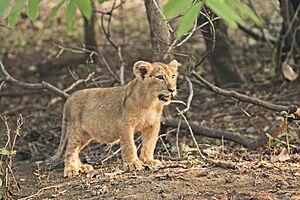
Iraq's wildlife includes its plants and animals, and their natural homes. Iraq has many different types of natural areas, from mountains in the north to wet marshlands along the Euphrates and Tigris rivers. The western part of the country is mostly desert.
The Mesopotamian Marshes in the middle and south are home to about 50 species of birds and rare fish. These marshes are very important for birds like the marbled teal and Basra reed-warbler. The Asiatic lion, though now extinct in the region, has been a strong symbol of Iraq throughout history.
During Saddam Hussein's government, the Mesopotamian Marshes were drained, which greatly harmed the wildlife. Since 2003, water flow has been restored, and the ecosystem has started to recover. Iraq's corals are very tough, able to survive in seawater temperatures between 14 and 34°C (57 and 93°F). Major lakes like Lake Habbaniyah and Lake Mosul also support aquatic wildlife.
Government and How Iraq is Run
Iraq's government is a democratic, federal parliamentary republic. This is set out in its current Constitution. The government has three main parts: the executive (like the President and Prime Minister), the legislative (which makes laws), and the judicial (which interprets laws). There are also many independent groups.
Iraq is divided into regions and governorates, which have their own powers. The president is the head of state, and the prime minister is the head of government. The country has two law-making bodies: the Council of Representatives and the Council of Union. The courts are independent.
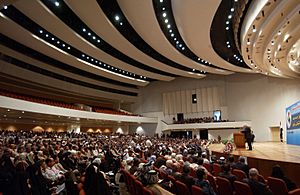
The National Alliance is the main Shia political group in parliament. The Iraqi National Movement is led by Iyad Allawi, who is supported by many Sunnis. The Kurdistan List is mainly made up of two Kurdish parties. Baghdad is Iraq's capital and the center of government. The "Green Zone" in Baghdad holds government buildings, the army headquarters, and foreign embassies.
In 2023, Iraq was considered the third most democratic country in the Middle East for elections.
Laws in Iraq
In October 2005, a new Constitution of Iraq was approved by a large majority. This new constitution was supported by Shia and Kurdish communities but not by Arab Sunnis. Under this constitution, new parliamentary elections were held in December 2005.
Iraq's laws are based on French civil law and Islamic law (Sharia). For example, a law from 1959 made polygamy (having more than one spouse) very difficult and gave child custody to mothers in divorces. While Iraq does not have separate Sharia courts, civil courts use Sharia for personal matters like marriage and divorce.
Iraq's Military Forces
Iraq's security forces are made up of groups under the Ministry of Interior and the Ministry of Defense. The Iraqi Counter Terrorism Bureau reports directly to the prime minister and oversees special forces. The Ministry of Defense includes the Iraqi Army, Iraqi Air Force, Iraqi Navy, and Peshmerga (Kurdish forces). These groups are responsible for security.
The modern Iraqi armed forces were rebuilt with American help and military aid. The army has 14 divisions, mostly infantry. Before 2003, Iraq used mostly Soviet-made military equipment, but now it uses Western suppliers.
The Iraqi air force supports ground forces with surveillance and troop transport. It has light aircraft and helicopters. The air force currently has 5,000 personnel. The navy has about 5,000 sailors, including marines, and protects coastlines and waterways. Other countries, like Australia and New Zealand, have helped train Iraqi security forces.
International Relations
After the Iraq War, Iraq worked to improve its relationships with neighboring countries and increase economic cooperation. In 2009, Iraq joined the Chemical Weapons Convention, agreeing to destroy its chemical weapons stockpiles.
Iraq has tried to balance its relationships with both Arab neighbors and Iran. Relations with Iran have grown stronger since 2005. Relations with Turkey can be tense, partly because of issues with the Kurdistan Region and water supply from Turkish projects. Prime Minister Mohammed Shia' Al Sudani has worked to improve relations with Syria and other Gulf countries. Iraq and Kuwait are also working on a final agreement for their border.
In 2008, the US and Iraq agreed on a plan for US troops in Iraq. In January 2020, the Iraqi parliament voted for a resolution asking the government to work on removing US troops from Iraq. This happened after a US drone strike killed an Iranian general in Baghdad. The US later reduced its military presence in Iraq after ISIS was defeated.
Human Rights in Iraq
Relations between Iraq and its Kurdish population have been difficult in the past. For example, Saddam Hussein's campaign against them in the 1980s was very harsh. After uprisings in the early 1990s, many Kurds fled, and "no-fly zones" were set up in northern Iraq to protect them. Despite past problems, progress has been made. Iraq elected its first Kurdish president, Jalal Talabani, in 2005. Also, Kurdish is now an official language of Iraq alongside Arabic.
LGBT rights in Iraq are limited, and homosexuality is still looked down upon in Iraqi society. Human rights were severely violated in areas controlled by ISIS, including mass killings and the Yazidi genocide.
Administrative Divisions
Iraq is divided into nineteen governorates (like provinces). These governorates are further divided into districts, and then into sub-districts.
Iraq's Economy
Iraq is a country rich in oil. Its economy mainly relies on the oil sector, which provides about 95% of its foreign earnings. Because other parts of the economy are not as developed, unemployment is high. The official money in Iraq is the Iraqi dinar.
Before 2003, Iraq's economy was centrally planned, meaning the government controlled most large industries. Foreign ownership of businesses was not allowed. Oil was nationalized in 1972, and its money was used for government projects. However, sanctions placed on Iraq after 1990 hurt its economy. After 2003, the government began to open up the economy to foreign investment. In 2004, many countries agreed to cancel a large part of Iraq's debt.
Years of conflict have greatly affected Iraq's economy. Many people were displaced, and many Iraqis faced food shortages. However, Iraq has shown signs of recovery. The Kurdish and Shia regions have seen economic growth. In recent years, Sunni-populated areas have also made progress with new construction projects. In 2025, Iraq's parliament speaker stated that the country is stable in terms of security and economy. Iraq is also an agricultural country.
Tourism in Iraq
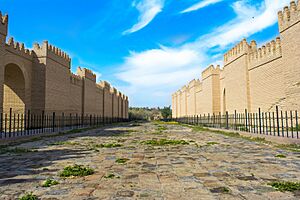
Iraq used to be an important tourist destination, but this changed during wars and conflicts. As Iraq becomes more stable, tourism is slowly growing. The country has huge potential for tourism, especially for its ancient sites and religious places.
Many ancient sites are being restored. Babylon, famous for its Ziggurat (which inspired the Biblical Tower of Babel), the Hanging Gardens, and the Ishtar Gate, is a major attraction. Nineveh and Ur, one of the first Sumerian cities, have also seen restoration.
Iraq is also a popular place for religious tourism, especially for pilgrimages to holy Shia Islamic sites near Karbala and Najaf. Since 2003, these cities have seen an economic boom due to religious visitors. The Mosul Museum and the National Museum of Iraq in Baghdad house amazing ancient artifacts.
Saddam Hussein built many palaces across the country. Some of these, like Al-Faw Palace, are now open to tourists. The government is thinking about selling them for other uses.
Transportation in Iraq
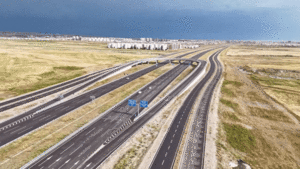
Iraq has a modern network of motorways, covering about 45,550 kilometers (28,300 miles). These roads connect Iraq to neighboring countries like Iran, Turkey, Syria, Jordan, Saudi Arabia, and Kuwait. Many roads were built in the late 1970s and early 1980s but were damaged during wars. Traffic can be a big issue, especially in Baghdad.
Iraqi Republic Railways manages railway transportation. The government plans to connect its railways with Turkey, Kuwait, and Saudi Arabia to create a continuous Euro-Gulf rail route. A large project is underway to connect Karbala and Najaf by rail.
Most of Iraq's oil exports go through its ports. Basra is Iraq's only coastal governorate and is home to all six of Iraq's ports, including the Grand Faw Port, which is planned to be the largest in the Middle East. Iraq also has about 104 airports. Major airports are in Baghdad, Basra, Erbil, and Sulaymaniyah. New international airports are being built in Karbala and Nasiriyah.
Oil and Energy
Iraq has the third-largest proven oil reserves in the world, after Venezuela and Saudi Arabia. Oil production reached 3.4 million barrels per day by December 2012. Iraq was one of the founding members of OPEC, an organization of oil-producing countries.
In the 1970s, Iraq produced up to 3.5 million barrels of oil per day. However, sanctions after the 1990 invasion of Kuwait severely damaged the oil sector. The sanctions were lifted in 2003, but conflicts have slowed the development of Iraq's oil resources. Despite improved security and billions in oil revenue, Iraq still struggles to provide enough electricity for its people.
In 2009, Iraq's Ministry of Oil signed contracts with international oil companies to develop some of its large oil fields, including the "super-giant" Majnoon oil field. In 2014, Iraq's oil output jumped to 3.6 million barrels a day, the highest since 1979. However, later that year, Kurdish forces took control of some oilfields in the north, causing disputes with Baghdad. As of 2021, the oil sector provides about 92% of Iraq's foreign earnings.
Water Supply and Sanitation
Decades of war have greatly damaged Iraq's water management system in many major cities. This has led to widespread shortages of water supply and poor water quality. While large lakes help with supply, many businesses and homes are not fully aware of environmental issues or following laws.
About 91% of the population has access to safe drinking water. In rural areas, 77% have access to improved drinking water sources, while in urban areas, 98% do. However, much water is wasted during treatment because of old equipment.
Infrastructure Development
At the end of 2013, Iraq faced a housing crisis. The country needed to build 2.5 million homes by 2016 to meet demand. In 2013, a South Korean company agreed to build Bismayah New City, which would house about 600,000 people in 100,000 homes.
In December 2020, the second phase of the Grand Faw Port project began. In late 2023, the government announced plans to build 15 new cities across Iraq to solve the housing problem. The first five new cities will be in Baghdad, Babylon, Nineveh, Anbar, and Karbala. The first new city, Al-Jawahiri, began construction in late 2023 and will have 30,000 housing units.
In 2024, Iraq, Turkey, Qatar, and the UAE signed an agreement for the Iraq Development Road project. This project includes a 1,200-kilometer (746-mile) railway and motorways connecting the Grand Faw Port to the Turkish border. It is expected to be completed by 2025 and will strengthen Iraq's position as a trade hub.
Iraq's People and Culture
Iraq's population was estimated to be 46.1 million in 2024. It is the most populated country in the Arabian Plate. Iraq's native population is mostly Arab, but it also includes other ethnic groups like Kurds, Turkmen, Assyrians, and Yazidis.
Cities and Towns
|
Largest cities or towns in Iraq
|
||
|---|---|---|
| Rank | Name | Pop. |
| 1 | Baghdad | 6,719,477 |
| 2 | Mosul | 1,361,819 |
| 3 | Basra | 1,340,827 |
| 4 | Erbil | 1,550,071 |
| 5 | Kirkuk | 972,272 |
| 6 | Najaf | 747,261 |
| 7 | Karbala | 711,530 |
| 8 | Sulaymaniyah | 676,492 |
| 9 | Nasiriyah | 558,446 |
| 10 | Amarah | 527,472 |
Ethnic Groups in Iraq
Iraq's population is mainly Arab, but it also includes other groups like Kurds, Turkmen, Assyrians, and Yazidis. In 2015, estimates suggested there were about 24 million Arabs (14 million Shia and 9 million Sunni), 4.7 million Sunni Kurds, and 3 million Turkmen. There are also smaller groups like Christians, Yazidis, Shabaks, and Mandaeans.
Historically, census figures have been difficult to trust because people were often only allowed to choose "Arab" or "Kurdish" as their ethnic group. This made it hard to count other minorities accurately.
Languages Spoken in Iraq
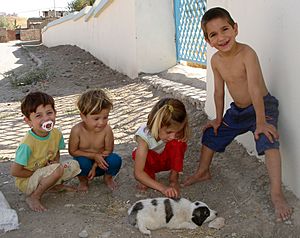
The main languages in Iraq are Mesopotamian Arabic and Kurdish. Other languages include the Turkmen dialect of Turkish, and Neo-Aramaic languages like Chaldean and Assyrian. Arabic and Kurdish are written using versions of the Arabic script. Turkmen uses the Turkish alphabet, and Neo-Aramaic languages use the Syriac script. Smaller minority languages include Mandaic, Shabaki, Armenian, Circassian, and Persian.
Before 2003, Arabic was the only official language. Since the 2005 Constitution of Iraq, both Arabic and Kurdish are official languages. Turkmen, Syriac, and Armenian are also recognized as minority languages. Iraqis have the right to educate their children in their mother tongue in government schools.
Religions in Iraq
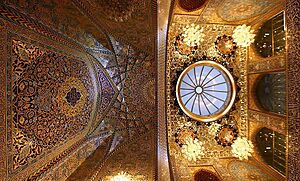
Most people in Iraq follow Abrahamic religions. In 2020, about 97% of Iraqis were Muslim, with 61% being Shia and 35% Sunni. Christianity accounted for about 1%, and other religions like Yazidism and Mandaeism made up the rest. Iraq is home to two of the holiest places for Shia Muslims: Najaf and Karbala. Shia Muslims are mostly found in southern Iraq and parts of Baghdad. Sunni Muslims are mainly in the "Sunni Triangle" region, including cities like Ramadi and Fallujah.
Christianity in Iraq has a very long history, dating back to the 5th century AD. Iraqi Christians are mainly Assyrians belonging to different churches. There are also Armenian Christians who came to Iraq after fleeing Turkey. The number of Christians in Iraq has decreased significantly since the 2003 invasion due to violence and persecution.
Iraq is also home to one of the oldest Jewish communities in the Middle East. In 1948, there were about 200,000 Jews. Many left after Israel was established. Today, only a small number of Jews remain in Iraq.
There are also small groups of Mandaeans, Shabaks, Yarsan, and Yazidis. Yazidis are mostly found around the Sinjar Mountains. Mandaeans live mainly around Baghdad, Fallujah, Basra, and Hillah.
Iraqi People Abroad and Refugees
The movement of Iraqis to other countries is known as the Iraqi diaspora. After the 2003 invasion, nearly two million Iraqis fled the country. In 2021, about 1.1 million people were displaced within Iraq. In 2007, it was estimated that 40% of Iraq's middle class had left. However, as security improved, some refugees began to return.
By 2011, nearly 3 million Iraqis had been displaced. More than half of Iraqi Christians had left the country since the US-led invasion. After the Syrian Civil War began in 2011, many Iraqis in Syria returned home. Also, over 252,000 Syrian refugees have fled to Iraq since 2012 to escape the war in Syria.
Health and Healthcare
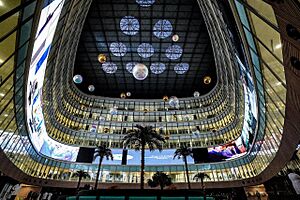
In 2010, Iraq spent about 6.84% of its GDP on healthcare. In 2008, there were about 7 doctors and 14 nurses for every 10,000 people. Life expectancy at birth was about 68.5 years in 2010. Officially, healthcare in Iraq is free. However, years of wars and instability have greatly affected the healthcare system.
In the 1970s, Iraq had a strong, free healthcare system with modern hospitals. It relied on importing medicines and equipment. Before 1990, most people had access to free primary healthcare.
In 2024, Mohammed Shia' Al Sudani opened Shaab General Hospital in Baghdad, the city's first new general hospital in almost 40 years. This hospital has modern equipment and offers a full range of services. The Ministry of Health has also built 13 new hospitals and many specialized centers in the past two years. Plans are in place to build 16 more hospitals.
Education in Iraq
Before 1990 and 2003, Iraq had a very good education system. However, it has faced challenges since then. Despite this, school enrollment has nearly doubled from 2000 to 2012, reaching six million students. By 2015–2016, about 9.2 million children were attending school.
The rapid increase in students has put a strain on the system. Education receives only a small part of government spending, leading to a lack of investment in schools. Many students drop out or repeat grades. Dropout rates are higher for girls due to economic or family reasons.
Access to education varies across Iraq. In conflict-affected areas, many school-aged children are out of school because schools have been used as shelters or military bases. However, efforts are being made to reopen schools. In Mosul, over 380,000 children are back in school.
In 2024, the government opened 790 new schools across the country as part of an agreement with China to build 1,000 schools. This project aims to reduce overcrowding and the need for schools to operate multiple shifts, which limits learning time. The prime minister also announced plans to build 400 more schools with the private sector to address the shortage of over 8,000 schools in the country.
Iraqi Culture
Iraq's culture has a very deep history, going back to ancient Mesopotamian times. Iraq has one of the longest traditions of written works, including in architecture, literature, music, dance, and painting. The culture of Iraq is considered one of the world's oldest and most influential.
The legacy of Mesopotamia includes inventing writing, mathematics, ways to measure time, the calendar, astrology, and law codes. Iraq is home to many different ethnic groups, and each has added to the country's rich heritage. Iraq is known for its talented poets, architects, painters, and sculptors. The country also produces beautiful handicrafts, like rugs and carpets.
Art in Iraq
Ancient Iraq had several connected art traditions. During the Abbasid Caliphate (750-945 AD), art flourished, especially in Mesopotamia. Abbasid art was influenced by Mesopotamian traditions and later by Persian and Central Asian styles. Pottery became very detailed, and calligraphy was used to decorate objects and books, especially Qur'anic texts. Iraq's first art school was set up during this time, helping artists and craftspeople thrive.
In the late 12th century, a special style of manuscript illustration and calligraphy emerged, known as the Baghdad School. This Islamic art style showed everyday life and used very expressive faces, unlike the more common, less detailed characters seen before.
Iraqi Architecture
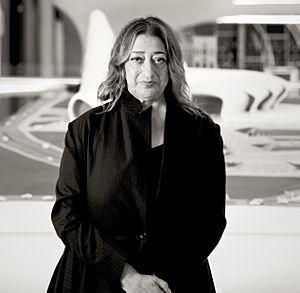
Iraq's architecture has a long history, from 10,000 BC, including both Mesopotamian and Abbasid architecture. Baghdad and Mosul have many historic buildings. There are many historic mosques in Baghdad and Basra, old churches in Mosul, and synagogues in Baghdad. Famous modern architects from Iraq include Zaha Hadid.
Ancient cities like Nineveh were buried for centuries until they were rediscovered in the 1800s. The remains show large palace-temples built mainly of sun-dried bricks, decorated with sculptures and paintings.
In recent years, modern buildings like shopping malls and tall towers have been built. Iraq was one of the first countries in the Middle East to adopt mall culture. Important cultural places in Baghdad include the Iraqi National Symphony Orchestra and the National Theatre of Iraq. Baghdad also has museums, including the National Museum of Iraq, which holds a huge collection of artifacts from ancient Iraqi civilizations. In 2021, Iraq announced it had brought back about 17,000 looted artifacts, a major achievement.
Iraqi Literature
Literature in Iraq is often called "Mesopotamian literature" because of the many civilizations that thrived there. Sumerian literature was unique because its language is not related to any other known language. It started with symbols and later developed into cuneiform writing on clay tablets. Early literature often told stories about creation, gods, and heroes, like the Epic of Gilgamesh, which is one of the oldest surviving literary works.
During the Abbasid Caliphate, the House of Wisdom in Baghdad was a major center for scholars and writers. Many stories in One Thousand and One Nights feature famous Abbasid figures. Iraq has many famous medieval poets. In modern times, Iraqi literature uses Arabic, Neo-Aramaic, Kurdish, and Turkish languages. Arabic literature remains the most influential.
Music of Iraq
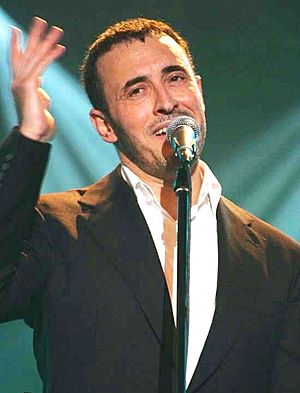
Iraq is well-known for its rich maqam heritage. The Iraqi maqam is considered a very special and perfect form of this musical style. It involves sung poems written in classical Arabic or Iraqi dialect. UNESCO recognizes this art form as an "intangible heritage of humanity."
In the early 20th century, many leading musicians in Iraq were Jewish. In 1936, Iraq Radio was established with an ensemble made up almost entirely of Jewish musicians. Famous singers like Salima Pasha were very popular, which was unusual at a time when public performances by women were often seen as shameful.
Media in Iraq
Iraq was home to the second television station in the Middle East, which started in the 1950s. After the government's full control ended in 2003, there was a big increase in broadcast media. By 2003, there were many Iraqi-owned radio stations, television stations, and newspapers.
The US invasion in 2003 had a big impact on Iraqi media. After the war, there was a period of growth in media outlets.
Iraqi Cuisine
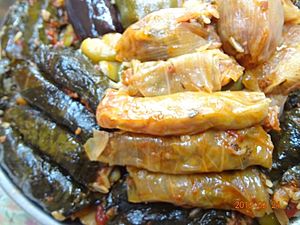
Iraqi cuisine dates back about 10,000 years to the Sumerians, Akkadians, Babylonians, Assyrians, and ancient Persians. Tablets found in ancient ruins in Iraq show recipes from religious festivals, which are considered the world's first cookbooks. It was during the Islamic Golden Age, when Baghdad was the capital of the Abbasid Caliphate, that Iraqi cooking reached its peak. Today, Iraqi food reflects this rich history and has strong influences from Turkish, Iranian, and Syrian cooking.
Some common ingredients in Iraqi cuisine include vegetables like eggplant, tomato, okra, onion, and potato. Grains like rice, bulgur wheat, and barley are also important. Fruits such as dates, raisins, apricots, and figs are used. Like other countries in Western Asia, chicken and especially lamb are favorite meats. Most dishes are served with rice, usually Basmati rice grown in the marshes of southern Iraq.
Sports in Iraq
Football is the most popular sport in Iraq. Other popular sports include basketball, swimming, weightlifting, bodybuilding, boxing, kickboxing, and tennis.
The Iraq Football Association manages football in Iraq, including the Iraq national football team. It was founded in 1948 and has been a member of FIFA since 1950. Iraq won the 2007 AFC Asian Cup and participated in the 1986 FIFA World Cup.
Images for kids
-
The Neo-Babylonian Empire under Nabonidus (556–539 BC) at its greatest territorial extent.
See also
 In Spanish: Irak para niños
In Spanish: Irak para niños




